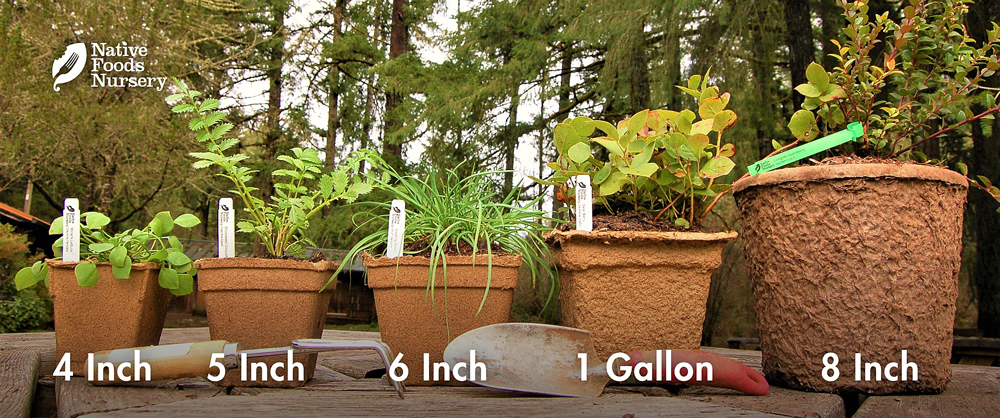Thimbleberry
- Current Stock:
- 0
- Other Names:
- Western Thimbleberry, Wa-sa'
- Latin Name:
- Rubus Parviflorus
Thimbleberry is a unique bramble native to the Western states with clusters of sweet red fruits, white star-shaped flowers, and big velvety maple-like leaves.
Edible Uses
Thimbleberries are native food prized for their bright red berries that ripen in summer. They have a sweet and unique taste all their own (especially those grown in full sun), with a pleasant crunchy texture from the tiny seeds in each drupelet. A delicious summer treat, or great for jellies.
Young spring shoots are also quite tasty. They are first peeled, and then eaten raw or cooked like asparagus.
Native American peoples, wild foragers, and sustainable gardeners have and continue to value this plant for both food and a myriad of medicinal uses, including skin and digestive ailments. Both berries and shoots are rich in Vitamin C and A.
NOTE: Observations have been made that Thimbleberries produce significantly less fruit in southern regions of the country - perhaps USDA zone 8 and higher.
Ornamental Qualities
The combination of soft maple-shaped leaves (turning golden yellow in Fall), large pure-white flowers, and pink to red berry clusters makes Thimbleberries a desirable ornamental plant for the home garden. Healthy plants slowly spread to form patches, like Raspberries, making them great around garden edges or as a view break. One of the only in the Rubus genus without thorns. Thimbleberries look beautiful alongside Blackcap Raspberry and Salmonberry.
Environment and Culture
Thimbleberries’ wild home is along rivers, forest edges, roadsides, and disturbed open areas throughout the Western states. It prefers moist areas, but can be found growing in the drier Eastern part of our region, as well. The berries are a huge hit with wildlife, especially birds, but also foxes, raccoons, squirrels, and other rodents. The flowers are nectar for butterflies and the young leaves are popular with deer. A great wildlife plant.
Thimbleberry is very low-maintenance and vigorous, especially if planted in a moist and sunny area. Vigorous root system can be used to stabilize banks and prevent erosion.
Northwest Native American tribes today still value this special plant as food, medicine, and family. Despite great cultural losses, they continue to work towards stewarding and restoring wild populations, both strengthening the integrity of the ecology and sustaining their cultural heritage and wisdom. These strong and recovering peoples and plants deserve our respect, gratitude, and reparations. (Learn more & how to help on our Charitable Giving page.)
NOTE: Thimbleberries produce better with cooler summers. If you live in the southern half of the U.S., plant them in mostly shaded areas.
Harvest, Care, and Preparation
Pruning is not necessary, but can increase harvest, decrease disease, and improve appearance. There are differing methods, but the main rule of thumb is to preserve the older canes, which produce better. Hence, don't prune everything to the ground each year. The easiest method is to grow a patch for three years, and then simply remove the oldest canes after fruiting each subsequent year. Then you'll have an even number of one, two, and three year-old canes.
Allow canes to reach two years of age Two to three year old canes produce much better. Harvest berries by hand when berries are fully red and soft. They should be soft to the touch and slide easily off the core. They are fragile when collecting and can be eaten fresh, dried, or made into preserves.
Young shoots should be harvested when still tender, lightly skinned, and cooked like asparagus. Only harvest one or two per plant per year (wait till you have a patch). Steam and serve as a side, or chop and mix in a vegetable stir-fry. Enjoy!
Native Range: Western States
USDA zones: 3-7
Ease of Care: Very Easy
Deer Resistance: Low
Light Requirements: Full Sun to Mostly Shade (plant in shade in hot summer areas)
Soil Type: Any, prefers well-drained
Water Requirements: Any, prefers moist
Pollination: Self-Fertile
Bearing Age: 2 yrs from seed.
Size at Maturity: to 6 feet
Plant Spacing: 2-3 feet
Bloom Time: May/June
Harvest Time: July/August
Pot Sizing Guide

Our policy lasts 30 days. If 30 days have gone by since your purchase, unfortunately we can’t offer you a refund or exchange. To be eligible for a return, your item must be unused and in the same condition that you received it. It must also be in the original packaging. Gift cards are non-refundable. Once your return is received and inspected, we will send you an email to notify you that we have received your returned item. We will also notify you of the approval or rejection of your refund. If you are approved, then your refund will be processed, and a credit will automatically be applied to your credit card or original method of payment, within a certain amount of days.










